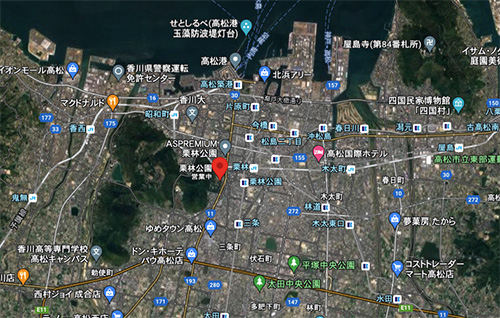


本日からふたたび住宅の歴史探訪に復帰いたします。
日本の精神史のなかで特異的だと思われるのが「大名庭園」という存在。
京都における宗教建築群から出自した庭園文化があり、
江戸期に至って大名の地域割拠体制が平和的に実現するなかで、
戦国期に発展した各地域での戦争土木技術が
各大名によって城下町建設技術基盤になりそれが庭園造成に活用された。
参勤交代制という特殊な体制から江戸と各地域双方で
そのような「庭園文化」が活況を呈した。結果「大名庭園」群が成立した。
戦国末に戦争が土木技術競争として盛り上がったことが基層にある。
武田信玄の穴山衆のような、あるいは秀吉の大土木集団などが
国土計画の中軸技術軍団として成立したことがあったのでしょう。
江戸の「新開地」建設において幕府は意図的に
宏壮な大名庭園群を新都市計画の中枢として取り込んでいった。
そういうことに経済力を浪費させて平和を実現させる効果もあった。
このあたりの知恵はロシア・プーチンに学ばせるべきだ・・・。
現代にも江戸城、皇居であるとか浜離宮など多数の庭園群が
東京で基盤的に景観形成していると思われる。
四国行脚していて高松に注目していくつかの都市計画視点、
いわば「ブラタモリ」的な見方というものに強く導かれて
この掬月亭を擁する「栗林公園」を見学していました。
高松城は瀬戸内海に直接アクセスする「水城」として築かれたとされる。
現在の高松駅と瀬戸内海の島嶼への連絡船埠頭は高松城に近接して立地する。
軍事的中核でありながら同時に商業発展を計画した都市構造。
ただ、そういった都市計画において高松の街は
計画以前には河川扇状地形平野であり、歴年、河川の氾濫に見舞われてきた。
本来この栗林公園や高松城域はそういった河川が流れていた地域だという。
そういった地域を獲得した大名家はその戦争力にもなっていた
土木技術を都市計画として活用させて河川流路の変更を行った。
航空写真地図では中央の山岳地形を迂回して栗林公園ー高松中心部に沿って
流れていた河川を南側(地図の下側)でせき止めて
左右に流路を変更していったのだと言われます。
今日まで残る栗林公園・大名庭園はその土木都市建設の結果、
残存した河川痕跡を主要な景観要素として利用したものだと。
掬月亭という名前は臨池庭園として水面に映える月を杯に映して
それを飲む、という風情を楽しむのだという命名とされる。
戦国以来の武士たちの戦争技術に於いて
土木建築計画というものが占めていた価値感を現代に伝えている。
そういった自然征服を可能にした自らの営為に対しての自己満足装置。
へそ曲がりな庶民階層としては大名庭園というのはそう感じられる(笑)。
まぁそうはいっても物事には肯定的な面と否定的な面と両面がある。
たしかに実現された景観美は面白いけれど、
時代的背景としてはそのような軍事要素も中核的事実としてあったと、
認識しながら、感受していきたいと思う次第です。
English version⬇
[Takamatsu Daimyo Garden “Kikugetsutei” ① Shikoku Living Space Exploration-26]
Ritsurin Garden was created by changing the flow path of the flooded river alluvial fan by civil engineering work. Drink the moon reflected on the surface of the pond in the remnants of the river.・ ・ ・
From today, we will return to the history of housing.
The existence of “Daimyo Garden” seems to be unique in the spiritual history of Japan.
There is a garden culture that originated from religious buildings in Kyoto,
As the daimyo’s regional allocation system was peacefully realized in the Edo period,
War civil engineering technology in each region developed during the Warring States period
Each daimyo became the construction technology base for the castle town, which was used to create the garden.
From the special system of attendance shift system in both Edo and each region
Such “garden culture” was booming. As a result, the “Daimyo Garden” group was established.
At the end of the Warring States, the war broke out as a civil engineering competition.
Like Shingen Takeda’s Anayama people, or Hideyoshi’s large civil engineering group
It must have been established as a core technology corps of national land planning.
The shogunate intentionally in the construction of “Shinkaichi” in Edo
The magnificent daimyo gardens were incorporated as the center of the new city planning.
It also had the effect of wasting economic power and achieving peace.
The wisdom around here should be learned by Putin, Russia …
Even today, there are many gardens such as Edo Castle, the Imperial Palace, and Hamarikyu Gardens.
It seems that the landscape is basically formed in Tokyo.
Shikoku pilgrimage and paying attention to Takamatsu, some city planning perspectives,
Strongly guided by a so-called “Bura Tamori” perspective
I was touring the “Ritsurin Garden” that houses this Kikugetsutei.
Takamatsu Castle is said to have been built as a “Mizujo” with direct access to the Seto Inland Sea.
The current ferry pier connecting Takamatsu Station and the islands of the Seto Inland Sea is located close to Takamatsu Castle.
An urban structure that is a military core but at the same time plans for commercial development.
However, in such city planning, the city of Takamatsu
Before the plan, it was a river alluvial fan plain and has been hit by river floods for many years.
Originally, this Ritsurin Garden and Takamatsu Castle area are said to be areas where such rivers flowed.
The daimyo who acquired such an area was also a war force.
The river channel was changed by utilizing civil engineering technology as a city plan.
The aerial map bypasses the central mountainous terrain and runs along Ritsurin Garden-Takamatsu center.
Dam the flowing river on the south side (lower side of the map)
It is said that the flow path was changed from side to side.
The Ritsurin Garden and daimyo garden that remain to this day are the result of the construction of the civil engineering city.
The remaining river traces were used as the main landscape element.
The name Kikugetsutei is a garden that reflects the moon that shines on the surface of the water.
It is named to enjoy the taste of drinking it.
In the war technology of the samurai since the Warring States
It conveys the sense of value occupied by civil engineering and construction plans to the present day.
A self-satisfaction device for one’s own activities that made it possible to conquer nature.
The daimyo garden feels like that for the common people who are bent over (laughs).
Well, even so, things have both positive and negative sides.
The landscape beauty that was realized is interesting, but
As a historical background, such a military element was also a core fact.
While recognizing it, I want to feel it.
Posted on 3月 18th, 2022 by 三木 奎吾
Filed under: 日本社会・文化研究







コメントを投稿
「※誹謗中傷や、悪意のある書き込み、営利目的などのコメントを防ぐために、投稿された全てのコメントは一時的に保留されますのでご了承ください。」
You must be logged in to post a comment.